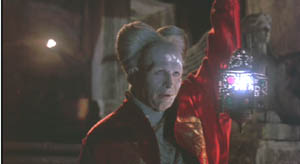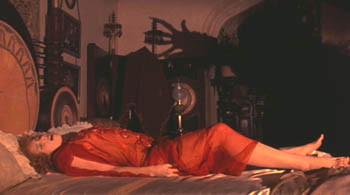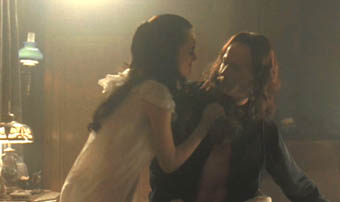|
It isn't, really. The rights to just plain "Dracula" were held by someone else at the time, but frankly "Francis Ford Coppola's Dracula" would've been more accurate in the end. In all fairness, much more of Stoker's novel got into this version than into any previous filmed version, but so did a great deal of additional material that the author most certainly never would've intended. 
The image of Bela Lugosi in his trademark black cape has become such an iconized version of the Dracula character that it's easy to overlook the fact that the original Tod Browning film had very little to do with the novel it was named for. Structurally, the Coppola film is far more faithful: various characters act as narrator throughout the film, reflecting the fact that the novel was presented as a series of letters and diary entries detailing (in remarkably prose-like detail) all the events from start to finish. Renfield plays his whole role from the insane asylum, though in the tradition of the first Dracula film, he's still said to have visited the Count at his castle in previous days. The "outing" of Dracula as a vampire results in a lengthy pursuit of the Count back to Transylvania. All the major points of the book are present, if often truncated. There's also a prologue detailing the now-popularized concept that Dracula was meant to be the risen Vlad Tepes, or "Vlad the Impaler," a conflation which was never explicitly made in the novel, although Vlad was a very likely source of inspiration. Stoker merely named him as "Voivode (governor) Dracula," and went so far as to say that "in life, [Dracula] was a most wonderful man," which one cannot really imagine anyone saying about Vlad Tepes, one of the more genuinely whacked and sadistic persons to have ever walked the earth. The Count's origins aside, the most drastic revision of the story is the presentation of Dracula as little short of a tragic hero, rather than, as Harvey Keitel would put it, a "lap dog of Satan." Vlad recognizes in heroine Mina Murray the perfect reflection of his own long-lost love Elisabeta. Cursing and renouncing God for allowing her to die while he was away defending the Catholic Church from the Turks, the Count embraces the dark powers to not only avenge himself, but to live long enough that his love might be found again. As Mina's fiance is left trapped in Dracula's castle, the Count journeys to London to find and seduce the apparent reincarnation of Elisabeta. Even after realizing what he is, Mina willingly gives herself up to him and embraces the idea of spending eternity together.  Nothing akin to this romanticization of Dracula appears in the book, which portrays him first and foremost as an abomination and an enemy of Christendom specifically. In the ninety-five years that passed between the publication of the original novel and this filmed production, there was a great amount of upheaval in the way we viewed the world, and to deem a character "evil" for being an enemy of the Christian religion could seem in our modern times either too bombastic, or given a growing enemies list that today includes such things as Marilyn Manson, Barney the dinosaur, and gay rights advocates, entirely too trite. The Mina of the novel dearly loved her fiance/husband Johnathan Harker, and he, along with his compatriots, were willing to die to save her from the grip of Dracula. By contrast, the Mina of Coppola's film seems almost as if she wished that Dracula would save her from the dreary existence of being married to the dullard of a legal clerk-and as he's played by Keanu Reeves, who could blame her? Similarly, the role of Van Helsing, the world's most famous vampire killer (or these days, at least the second most famous,) has morphed from the pious, grandfatherly figure of the book into what most people today would expect from a man who went raving on about vampires and such, i.e. a bit of a wacko. Anthony Hopkins is clearly having too much fun with his role, and by the end, he laments that the repressive forces of "decency" he leads have become "God's madmen." In the book, Johnathan discerns the evil nature of the Count's brides by the simple fact of, to put it simply, their wanton hotness. The sex appeal of vampires has done nothing but increase in the intervening years, but it's now perceived as an attractive quality, not a blasphemous impurity to be shunned. It's safe to say that the Mina of Stoker's book would've been fairly shocked by her screen counterpart's blatantly secular behavior. If there were an award given for most direction in a film, this one would win hands-down for its year. Every frame is packed full of lavish imagery, gorgeous lighting, and a vast wealth of clever camera shots (notice the label on the absinthe bottle as the glass is filled in the foreground,) plus a depiction of Mina and Johnathan's wedding which will likely give Godfather fans a tingling sense of déjà vu. In a deliberate attempt to create the atmosphere of a lavish stage play, Coppola decided-very wisely-to use practical effects for virtually every effect in the film. There are no awkward, distracting digital effects to knock one out of the feeling of the period, just good old-fashioned smoke-and-mirrors used to an exemplary degree. The lack of any obvious modern tricks such as morphing (well, except for one key shot) gives the film a much greater sense of magic, an approach I'd like to see emulated more (see the Mick Garris remake of The Shining for about a thousand examples of how not to depict magical/supernatural phenomena.) 
Gary Oldman gives a tour-de-force performance as the Count, making us forget very quickly the stage magician-garbed Lugosi image. Hopkins as Van Helsing, as previously mentioned, has a fantastic time with his over-the-top portrayal of a German scientist who's way too thrilled about stalking the undead. Winona Ryder plays Mina with a sweet but corruptible charm, and...well, personally I've never understood why anyone would hire Keanu Reeves when they could just get a hollow stick of a tree, fill it with some crack-addled woodpeckers to get in some basic movement, and stick it in front of the lens for a fraction of the cost. At least there are great portions of the story when he isn't about, and most of them are filled with Sadie Frost as Lucy Westenra, Mina's best friend and Dracula's first victim in London, who's quite sufficient to drive all Keanu-related concerns away. The author may not have approved of the skewed approach to his story-would that he'd lived to see it and express an opinion-but I do, and really, who are you gonna believe? -review by Matt Murray
|
|
||||||||